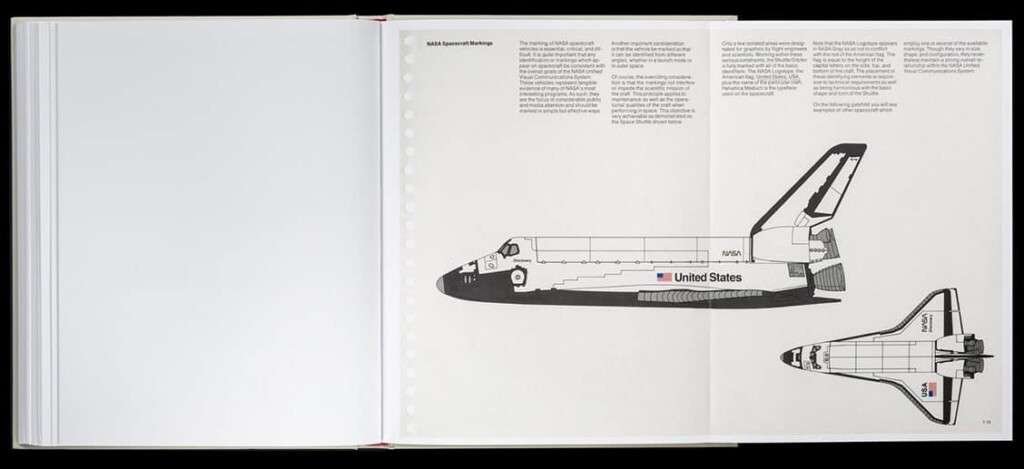A Glimpse into the NASA Graphics Standards Manual’s Creation and Contents
More than just a book, Richard Danne and Bruce Blackburn created the NASA Graphics Standards Manual for the organization that leads the way in science and exploration. The special anti-static packaging in which this manual is housed demonstrates the care and consideration that went into its physical form. The contents are rich and varied, including scans of the original manual from Richard Danne’s personal collection, an interesting article by Christopher Bonanos, and an introduction by Danne. The book also includes scans of the Manager’s Guide, a supplemental booklet provided by NASA, and copies of the original NASA 35mm slide presentation.
Documenting a critical juncture in NASA’s design history, this manual functions as both an artifact and a historical record. It serves as a testament to the importance of design and visual identity in influencing how a scientific organization is perceived and communicated.
The Need for a New Design and the Historical Context
NASA was transitioning from the heyday of the Apollo missions in the late 1960s and early 1970s. As part of the Project Mercury and Apollo programs, NASA had accomplished the historic feat of landing a man on the moon in 1969. However, NASA faced the problem of maintaining public attention and support. After the Apollo program ended in 1972, NASA struggled to maintain the excitement and passion of its earlier flights. During this time, President Richard Nixon pushed federal agencies to raise the bar on communication and design, resulting in the creation of the Federal Graphics Improvement Program by the National Endowment for the Arts (NEA).
One of the program’s first projects was with NASA. The agency chose the small but mighty New York firm of Danne & Blackburn for this massive overhaul because it needed a new brand to represent its ongoing mission and future ambitions.

The Origin and Meaning of the “Worm” Logo
The result of Danne and Blackburn’s work was the NASA Graphics Standards Manual, a comprehensive handbook that explained how to use NASA’s new logo on everything from space shuttles to letterhead. The “worm” logo, a sleek, contemporary style that allowed NASA’s divisions to present a cohesive front, served as the focal point of this new identity. With the introduction of this logo, NASA’s visual identity entered a new phase and underwent a dramatic change from the “meatball” style.
However, the “worm” was introduced to mixed reviews within NASA and encountered a number of difficulties over time. Despite these difficulties, NASA adopted the identification program, but returned to the “meatball” emblem in 1992. This decision highlighted the complex and often cyclical nature of branding and identity in large corporations.
Reprinting the Handbook: Preserving NASA’s Design Heritage
In a fascinating turn of events, 24 years after the “Worm” was discontinued, the NASA Graphics Standards Manual was reissued by designers Jesse Reed and Hamish Smyth to Richard Danne. The goal of this hardcover reprint was to honor and preserve the design history of the Worm, as well as the larger idea of NASA’s graphic standards.
Published by Standards Manual in 2015, this republished handbook serves as a link between historians and design enthusiasts and one of the most recognized scientific institutions in the world’s rich visual heritage. It offers readers the opportunity to own a piece of design history and provides a comprehensive look at a pivotal period in graphic design and government branding.

Summary
The NASA Graphics Standards Manual, written by Bruce Blackburn and Richard Danne, is a story about the transformative power of design and is more than just a set of principles. Anyone interested in the intersection of design, history, and space should read this book. It serves as a reminder of how visual identity can define and shape an organization’s future, and provides an in-depth look at the strategic thinking behind one of the most important identity redesigns in the history of government and science.
Where to Buy?
Jesse Reed and Hamish Smyth wrote the 220-page hardcover National Aeronautics and Space Administration Graphics Standards Manual. It was published by Standards Manual on September 1, 2015, and is the first edition. The designers are Bruce Blackburn and Richard Danne. This manual is an important piece of design history, featuring the iconic photographs that have come to define NASA’s identity. If you’d like a copy, you can get one here:
- Explore the interesting intricacies of NASA’s visual and branding requirements by reading the NASA Graphics Standards Manual, available on Amazon.
- Find a copy of the NASA Graphics Standards Manual on AbeBooks to see how the agency’s visual standards have evolved over time.
We hope this guide will help you obtain this important manual. Please note that this page contains affiliate links, which means that we may receive a small commission if you make a purchase through these links. It is because of your support that we are able to continue to provide insightful information to our readers. We are very grateful for your support.





